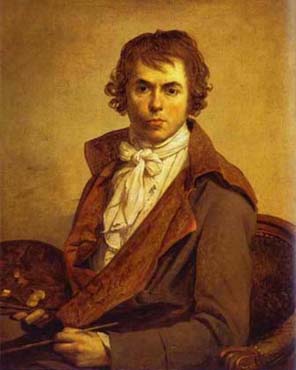The directory «Plots»
David Jacques Louis
(1748-1825)

Painter and political figure of the Revolutionary and Napoleonic periods in France. David is unique perhaps in the history of art for not only reflecting the spirit of his age, but for actually shaping that "spirit" through his own exertions and activities. His taste was that of Neo-Classicism, nurtured in him by his master Vien, by his stay in Rome and by his Jacobin doctrine. However, in the execution of his paintings even his contemporaries noted that he wandered from strict NeoClassicism in several ways that are to us indicative of his position as a modern artist. His most classic subjects, such as Oath of the Horatii (1784-85, Louvre), exhibit primitive disco-ordinated compositions that are not classic. His Directvire portraits are almost Rococo in taste. The imperial compositions which he produced for Napoleon are clearly Baroque in flavor. He is, then, an artist of distinct phases and changing tastes, at his best perhaps in his portraits of the Revolutionary period, which are more Realistic than Classical, according to modern usage of these terms.
As a youth David learned from both Boucher and Vien (see), two rather contradictory masters. The Neo-Classicism (see) that he learned from Vien eventually won out, but his competition piece of 1771, the Battle of Minerva and Mars. is an example of extremely vigorous Boucher style. It was only in Rome in the late 1770's that he was won over to the doctrine of Winckelmann and Mengs. This conversion culminated later in France in the Oath of the Horatii, stimulated by a ballet based on Corneille's Horace. He went back to Rome to complete it, and on exhibition it created a sensation. It was purchased by the government, although it spelled the downfall of the Ancien Regime. This painting, like the Socrates (1787, Metropolitan) and the Brutus (1789, Louvre), was fraught with a severe patriotic fervor: the masculine supremacy of civic justice over the feminine weakness of personal relationships. His paintings became a rallying cry for the Jacobins, and David was catapulted into power with the Terror. In the Convention he helped lead the Revolution; as artistic director he abolished the Academy and made designs for popular fetes. He documented the epoch with his Oath in the Tennis Court (1790, Louvre), an expanded Oath of the Horatii which is an early instance of the painting of contemporary history. His Death of Marat (1793, Brussels) is an eighteenth-century Pieta, the religious piece of the anti-clerical forces. Such portraits of that period as his own (1794) and that of Mme Chalgrin (1793) are among his most intense and powerful works.
The Directoire represented both political and artistic decline for David, although he received numerous commissions during that period. He withdrew into an aestheticism that produced pretty portraits like the unfinished one of Mme Recamier (1800, Louvre). An affected studio machine like the Sabine Women (1799, Louvre) seems to allegorize the conciliatory mood of the period. The style was a success, however, and David profited from exhibiting the Sabine Women in his studio at an admission charge. He declined to accompany Napoleon the Consul to Egypt, but accepted the position of first court painter from him as Emperor. For Napoleon he painted three major canvases, the first an idealized portrait of the Emperor astride a rearing horse in the Alps. Then in the tradition of the Tennis Court Oath, he painted two superb ceremonial subjects in which he combined a careful scrutiny of detail with Baroque space and verve. The Coronation of Napoleon (in which the Emperor actually crowns Josephine) was painted 1805-08; the Distribution of the Eagles in 1810. On the side (1800-14) he painted Leonidas at Thermopylae (Louvre), a work which demonstrates how insipid and precious his classical style became when it was not related to dynamic contemporary events. The Bourbons exiled David to Brussels and to an essentially sterile existence.
Stamps are here.
Guinea, 2011, Death of Marat
Guinea, 2011, Jacques-Louis David
Guinea, 2011, French presidents, Napoleon I, Bastille, Louis XVI
Guyana, 1993, Coronation of Napoleon
Maldives, 1990, Madame Pastoret
Maldives, 1990, Madame Trudaine
Maldives, 1990, Self-portrait (David)